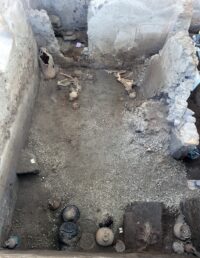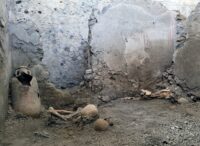 In the 18th century, the early days of semi-professional excavation at Pompeii under the Bourbon kings of Naples, the engineers directing the digs had a limited understanding of the overall dynamic of the eruption and no means of investigating the human remains they encountered for direct causes of death. They attributed all deaths to what they called the rain of ash, ie, pyroclastic flows.
In the 18th century, the early days of semi-professional excavation at Pompeii under the Bourbon kings of Naples, the engineers directing the digs had a limited understanding of the overall dynamic of the eruption and no means of investigating the human remains they encountered for direct causes of death. They attributed all deaths to what they called the rain of ash, ie, pyroclastic flows.
It’s only in recent decades that technology has given archaeologists the ability to distinguish the various ways Vesuvius’ eruption took lives. The pyroclastic flows were just the last stage. Before that, the pumice fall that pummeled the city for 18 hours, increasing the weight on roofs at a rate of 220 lbs per hour, caused buildings to collapse on top of people who had sought shelter there.
 The most recent find of two skeletons beneath a collapsed wall in the House of the Chaste Lovers were victims of yet another effect of the eruption of 79 A.D.: an earthquake that struck just before the final phase of pumice fall and prior to the pyroclastic flows that buried the city. The skeletons were found during structural work on the House of the Chaste Lovers. They were adult males (at least 55 years old) who had taken refuge in a utility room that was not in active use at the time of the eruption because the building was undergoing renovations.
The most recent find of two skeletons beneath a collapsed wall in the House of the Chaste Lovers were victims of yet another effect of the eruption of 79 A.D.: an earthquake that struck just before the final phase of pumice fall and prior to the pyroclastic flows that buried the city. The skeletons were found during structural work on the House of the Chaste Lovers. They were adult males (at least 55 years old) who had taken refuge in a utility room that was not in active use at the time of the eruption because the building was undergoing renovations.
Several objects came to light in the room where the bodies lay, such as a upright amphora leaning against the wall in the corner near to one of the bodies and a collection of vessels, bowls and jugs stacked against the end wall. The most striking aspect is the evidence for the damage to the two walls, probably caused by the earthquakes that accompanied the eruption. Part of the south wall of the room collapsed, crushing one of the men whose raised arm offers a tragic image of his vain attempt to protect himself from the falling masonry. The conditions of the west wall demonstrate the tremendous force of the earthquakes that took place at the same time as the eruption: the entire upper section was detached and fell into the room, crushing and burying the other individual.
The adjoining room has a stone kitchen counter, which was temporarily out of use in AD 79: a pile of powdered lime waiting to be used for building purposes was found on the surface of the counter, suggesting that repair work was being carried out nearby at the moment of the eruption. A series of Cretan amphorae, originally used for transporting wine, were found alongside the wall of the kitchen. Above the kitchen counter were traces of a domestic shrine in the form of a fresco which appears to depict the household gods (lares) and a pot partly set into the wall which may have been used as a container for religious offerings. Next to the kitchen, there is a long narrow room with a latrine, the contents of which flowed into a drain beneath the street.
The skeletal remains were removed by archaeologists for analysis in Pompeii’s on-site laboratory.